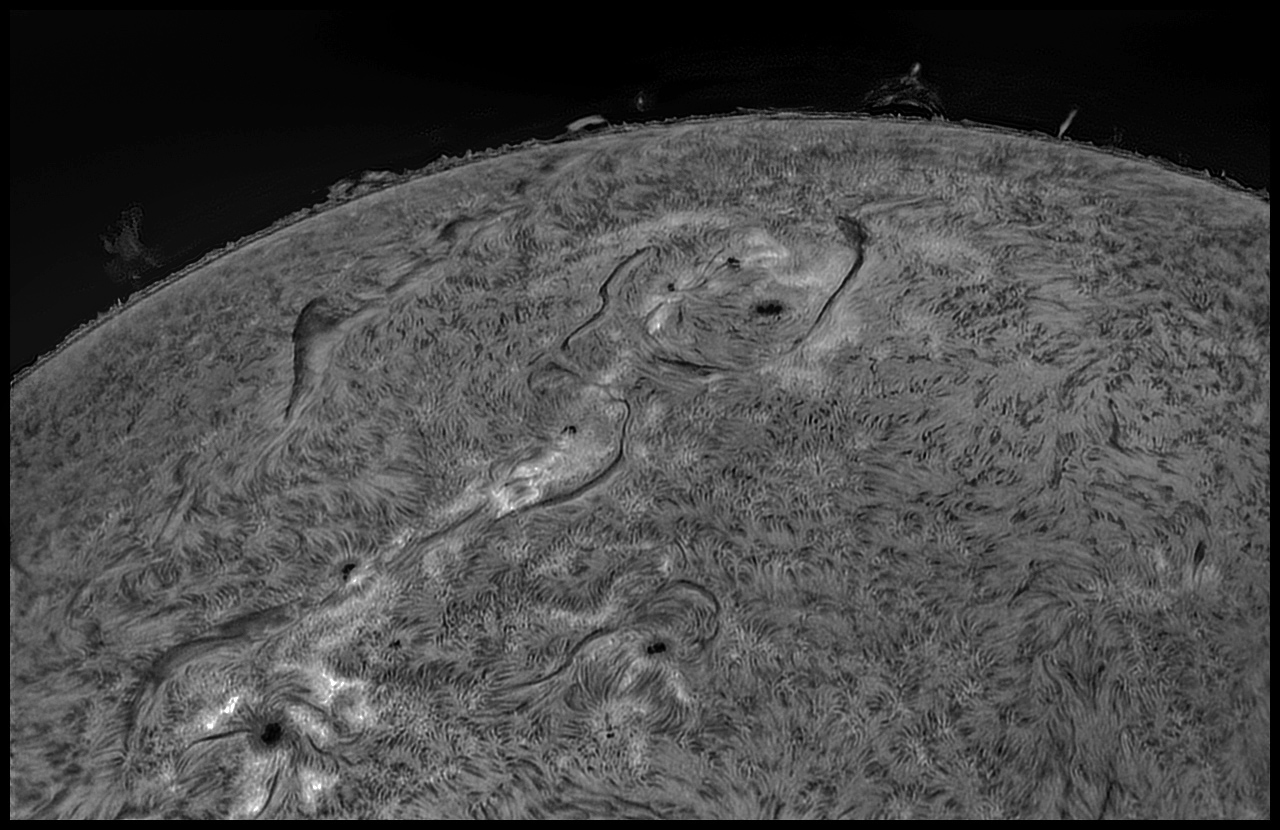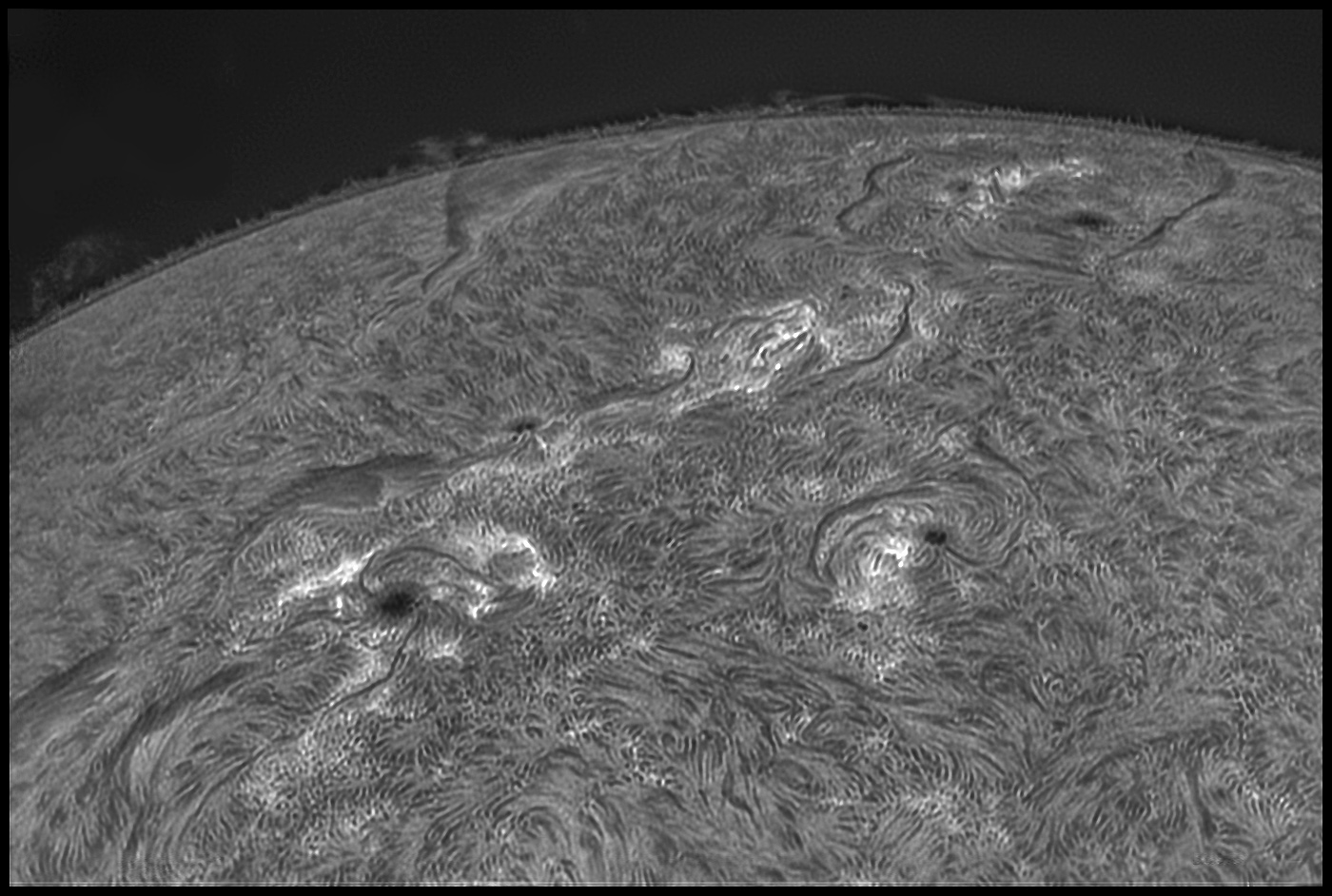A 7nm Surprise
9/08/2024. I had no idea that the Baader 7nm H-a filter I've been using as an IR-cut filter was so important to my solar images. I thought it was a safety (only) item. But today, when I put the kit back together after a few weeks of storage, I opted not to reinstall the 7nm filter, and I got crap for photos. I thought something else was amiss, but the issue was the missing filter. With a great deal of post processing, I recovered decent detail from the data taken without the 7nm filter, but it required heroic-level processing. After returning the filter to the nose of the A-P diagonal, better detail was just a couple of clicks away.

The Sun as it's supposed to look. 4 panel panorama,
best 300 of 3,000 frames times four. Click it!
I don't know for sure that the 178MM is being flooded by near IR in the absence of the 7nm filter, but for whatever reason, it works much better with the filter.
I'm wondering if I have other IR-cut filters I could use to get even better results, or if better filters are available. It seems likely that a simple IR-cut filter could replace this somewhat high-end option, or perhaps the narrow bandpass provides additional benefits. A comment on one of the solar imaging sites holds that the 35nm Baader has better IR-cutoff than the 7nm, but Baader says the 7nm is, indeed, "IR blocking." I have not found a definitive spectral curve from Baader. In any event, Baader has discontinued the 35nm version in favor of a 20nm filter which is said to cut from 800-1400nm. I'd rather not buy another H-a filter, especially "on spec."
9/10/2024. Aha! as expected, an IR-cut filter was supplied with at least one of my ZWO cameras. In the order in which sunlight encounters its components, I have the following optical train ready to try:
- telescope objective
- 7nm Baader H-a filter
- A-P diagonal mirror
- ZWO IR-cut filter
- Quark
- Antares 0.5x reducer
- 178MM
camera
Today's seeing is not as good as during the last session, and transparency is also reduced (and is slightly variable). Here's a schematic diagram so I can talk about what arrangements I've tried and how they work without handwaving. Note that the optical component labeled "2" is the IR-suppressing dielectric mirror in the A-P diagonal; it was common to all cases. Note to self: the data from today's trials are stored in AS!4 .tiff stacks (200 of 1,000 frames in each case) in today's solar data archive. The four-digit reference numbers identify each stack if it ever seems worthwhile to pull them up for a closer look.

Objective, telecompressor, sensor in blue. IR-cut components in black. Daystar Quark in red.
- I started with the 7nm H-a filter (1) and the ZWO IR-cut filter in alternate position (3a). The result is image-stack #1557.
- I removed the ZWO IR-cut filter and kept only the 7nm H-a filter. #1559
- I removed the 7nm H-a filter, too. #1602
- I put the IR-cut filter back in the train in position #3a. #1604
- I moved the IR-cut filter to preferred position #3. #1607
- I replaced the 7nm H-a filter in position #1. #1611
Here's how it fell out: First, there's no appreciable difference between stacks 1604 and 1607 or between stacks 1557 and 1611. Leave the IR-cut filter on the Quark so it does not need not to be swapped out with camera and snout changes. In position 3, it also offers the Quark some protection.
Either filter used by itself works well. There's very little relevant difference between 1559 and 1604. images are only slightly improved when both filters are used. But they do seem to be improved.
One possible reason not to use the 7nm H-a filter on the front of the diagonal is that it reflects energy back toward the objective. The reflected beam does not come to focus on the objective in the TMB92SS, but be aware of the possibility.
The performance of the ASI178MM and Quark were abysmal without at least one IR-cut filter. Exposures without any IR reduction were on the order of 10x shorter than with either filter, which suggests that the filters reduce the detected flux reaching the sensor by that amount. Most of it is not H-a.
Either filter used by itself required 2ms exposures. With both filters in place, exposures were 2ms and 3ms (I put this range down to varying sky transparency over an interval of 15 minutes). By this measure, the use of a second filter may seem redundant. Nevertheless, I suspect a small improvement in image sharpness when using both (though, again, all variables are not controlled -- sky conditions and idiosyncratic focus may account for some or all observed differences, and I did not make fresh flats for each configuration).
When you put the 152mm into service, consider replacing the 7nm H-a filter with a 2-inch IR cut filter (from ~$30) to protect the Quark and to prevent exposing the pricey 7nm H-a to so much energy. SVBony makes inexpensive IR-cut filters; ZWO's are also relative bargains, and this experience with ZWO's 1.25-inch version suggests that they work well. Baader and Optolong provide other options. Choose your price point and consult spectral transmission curves. An IR-cut filter from Baloptik is said to be the best for this application owing to the substrate on which its coatings are laid down; it cuts IR out to 3 microns while the others begin to transmit again in the 1.3-1.5 micron regime (but that filter is consistently out of stock everywhere; it may have been discontinued, and its cost is unknown). Practically speaking, how much longer-wave IR actually transits the entire imaging train anyway? Note that by its numbers, the 7nm Baader H-a is not especially good for this application (its IR-cut performance is relatively unaggressive), but in practice it seems to work very well. The discontinued 35nm Baader is supposed to offer better IR suppression; the performance of their newer 20nm may or may not be comparable.) From all this, especially the good performance of my 7nm filter, I suspect that any of the IR-cut filters would suffice from a spectral-rejection standpoint, but some may (or may not) be superior with respect to reflections and wavefront accuracy.
All these words and no pretty pictures? Patience, Grasshopper. It's clear that at least one IR-cut filter is needed, and two work a little better. But good results can be teased out of any of these schemes (even the data taken with no cut filter is "salvagable" --sort of), so I'm not sure how to showcase comparisons fairly.
Here are two photos that worked well today. These stacks are the best 400 of 4,000 frames made using both IR-cut filters. The post-processing included deconvolution via BlurXterminator as well as the usual strategies.

Full-frame, not a panorama this time.

9/11/2024. I inserted a Schuyler 10nm H-a filter at position 3a. The three-fer made little difference, by which I mean no discernable difference, so let's not do that unless a different combination proves more effective. The following data were taken without the telecompressor.

Three blocking filters. Best 101 of 5,000 frames. (Over sharpened, damnit.)

Two filters. Best 200 of 4,000 frames.
The next frontier is learning to sharpen these solar images without over-thickening fine, dark filaments. I think of it as having thread-like detail "rope out." I am clearly over-sharpening somewhere along the way, probably in more than one place. I've tried a couple of promising workflows (details and starting points are in a .txt file in the data archive) but better to get some sleep before propounding on them. The key --one key-- seems to be being very, very light-handed with the parms for various deconvolution routines. Attempts to mitigate already roped out images have not been especially pleasing (emboss overlays, high pass overlays...), so avoid the problem in the first place. We have clouds and rain for a few days in the forecast, so this is a good area on which to concentrate for a while.
:: top ::